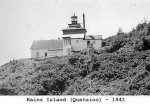In an earlier story I wrote about how the lighthouse keepers have been doing sea water samples since the early 1930s – some of the oldest observations on the BC coast!
Now, with satellites we can get different temperatures of the sea – Sea Surface Temperatures for one – similar to what the lightkeepers do, but globally.
Sea surface temperatures have a large influence on climate and weather. For example, every 3 to 7 years a wide swath of the Pacific Ocean along the equator warms by 2 to 3 degrees Celsius. This warming is a hallmark of the climate pattern El Niño, which changes rainfall patterns around the globe, causing heavy rainfall in the southern United States and severe drought in Australia, Indonesia, and southern Asia. On a smaller scale, ocean temperatures influence the development of tropical cyclones (hurricanes and typhoons), which draw energy from warm ocean waters to form and intensify. – NASA Earth Observatory Continue reading The Awfully Long Thermometer!






